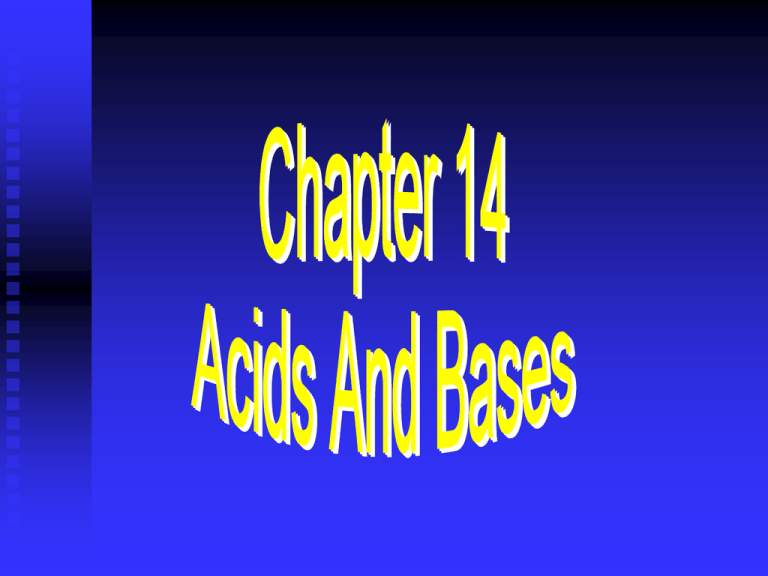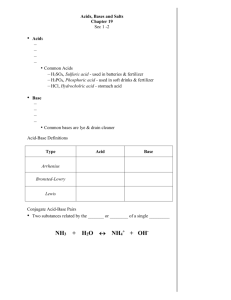Introduction to Acid/Base Chemistry
advertisement

Arrhenius Definition Acids produce hydrogen ions in aqueous solution. H2SO4, HCl, HC2H3O2 Bases produce hydroxide ions when dissolved in water. NaOH, KOH This definition is limited to aqueous solutions. Only one kind of base (a producer of OH-). NH (ammonia) is not a base using this definition. 3 Bronsted-Lowry Definitions And acid is an proton (H+) donor and a base is a proton acceptor. Acids and bases always come in pairs. HCl is an acid.. When it dissolves in water it gives its proton to water. HCl(g) + H2O(l) H3O+(aq) + Cl-(aq) Water is the base in the acid dissociation When water accepts proton it produces a hydronium ion (H3O+) Pairs Acids are always paired with conjugate bases General equation HA(aq) + H2O(l) H3O+(aq) + A-(aq) Acid + Base Conjugate acid (CA) + Conjugate base (CB) This is an equilibrium. There is competition for H+ between H2O and A The stronger base controls side that is favored. If H2O is a stronger base than A- it takes the H+ Equilibrium moves to right. Acid dissociation constant Ka The equilibrium constant for the general equation. HA(aq) + H2O(l) H3O+(aq) + A-(aq) Ka = [H3O+][A-] [HA] H3O+ is often written H+ ignoring the water in equation (it is implied). Acid dissociation constant Ka HA(aq) H+(aq) + A-(aq) Ka = [H+][A-] [HA] We can write the expression for any acid. Strong acids dissociate completely. Equilibrium lies far to product side. The conjugate base of a strong acid must be very weak. Back to Pairs Strong acids Weak acids Ka is large Ka is small [H+] is equal to [HA] dissolved A- is a weaker base than water [H+] << [HA] A- is a stronger base than water Types of Acids Polyprotic Acids- more than 1 acidic hydrogen (diprotic, triprotic). Oxyacids - Proton is attached to the oxygen of an ion. Organic acids contain the Carboxyl group -COOH with the H attached to O Organic acids are generally very weak. Amphoteric Compounds Compounds that behave as both an acid and a base. Water autoionizes 2H2O(l) H3O+(aq) + OH-(aq) Kw= [H3O+][OH-]=[H+][OH-] At 25ºC Kw = 1.0 x10-14 In EVERY aqueous solution @ 25oC. + -7 Neutral solution [H ] = [OH ]= 1.0 x10 + Acidic solution [H ] > [OH ] + Basic solution [H ] < [OH ] pH, pOH and pKa pH= -log[H+] Used because [H+] is usually very small As pH decreases, [H+] increases exponentially [H+] = 1.0 x 10-8 pH= 8.00 pOH= -log[OH-] pKa = -log Ka Relationships KW = [H+][OH-] -log Kw = -log([H+][OH-]) -log Kw = -log[H+]+ -log[OH-] pKw = pH + pOH Kw = 1.0 x10-14 pKW = 14 14.00 = pH + pOH [H+], [OH-], pH and pOH Given any one of these we can find the other three. [H+] 100 10-1 10-3 10-5 10-7 10-9 10-11 10-13 10-14 pH 0 1 Acidic 14 13 10-14 10-13 3 11 5 7 9 Neutral 9 7 5 11 3 13 14 Basic 1 0 pOH 10-11 10-9Basic 10-7 10-5 10-3 10-1 100 [OH-] Calculating pH of Solutions Always write down the major ions in solution This first step is the most important Remember these are equilibria You need to consider the direction Remember the chemistry Don’t try to memorize individual cases Technique is approximately the same Strong Acids HBr, HI, HCl, HNO3, H2SO4, HClO4 ALWAYS WRITE THE MAJOR SPECIES These are always completely dissociated No equilibrium [H+] = [HA]dissolved [OH-] is going to be small because of equilibrium -14 = [H+][OH-] 10 If [HA]< 10-7 water contributes H+ Weak Acids Ka will be small. ALWAYS WRITE THE MAJOR SPECIES. Approach as an equilibrium problem from the start. Determine whether most of the H+ will come from the acid or the water. Compare Ka or Kw Solve the problem like a normal equilibrium Example Calculate the pH, pOH and [OH-] of 2.0 M acetic acid HC2H3O2 with a Ka 1.8 x10-5 Example Calculate the pH, pOH and [OH-] of 0.15 M iodic acid HIO3 with a Ka 1.7 x10-1 Polyprotic acids Always dissociate stepwise. The first H+ comes of much easier than the second. Ka for the first step is bigger than Ka for the second. Denoted Ka1, Ka2, Ka3 Example Calculate the pH, pOH and [OH-] of 0.750 M phosphoric acid H3PO4 with a Ka1 = 7.50 x 10-3 Ka2 = 6.20 x 10-8 Ka3 = 4.20 x 10-13 Calculate the Concentration Of all the ions in a solution of 1.00 M Arsenic acid H3AsO4 Ka1 = 5.0 x 10-3 Ka2 = 8.0 x 10-8 Ka3 = 6.0 x 10-10 A mixture of Weak Acids The process is the same. Determine the major species. The stronger acid will always predominate. Ignore the weaker acid(s) Use the bigger Ka if concentrations are comparable Calculate the pH of a mixture 1.20 M HF (Ka = 6.8 x 10-4) and 3.4 M HOC6H5 (Ka = 1.3 x 10-10) Percent dissociation = amount dissociated x 100 initial concentration For a weak acid percent dissociation increases as acid becomes more dilute. Calculate the % dissociation of 1.00 M Acetic acid (Ka = 1.8 x 10-5) Calculate the % dissociation of 0.0100 M Acetic acid (Ka = 1.8 x 10-5) As [HA]o decreases [H+] decreases but % dissociation increases. Relate this to Le Chatelier The other way What is the Ka of a weak acid that is 8.1 % dissociated as 0.100 M solution? Bases The OH- is a strong base. Hydroxides of the alkali metals are strong bases because they dissociate completely when dissolved. The hydroxides of alkaline earths Ca(OH)2 etc. are strong dibasic bases, but they don’t dissolve well in water. The hydroxides of alkaline earths are used as antacids because [OH- ] can’t build up. Bases without OH Bases are proton acceptors. NH3 + H2O NH4+ + OHIt is the lone pair on nitrogen that accepts the proton. Many weak bases contain nitrogen B(aq) + H2O(l) Kb = [BH+][OH- ] [B] BH+(aq) + OH- (aq) Strength of Bases Hydroxides are strong. Others are weak. Smaller Kb weaker base. Calculate the pH of a solution of 4.0 M pyridine (Kb = 1.7 x 10-9) N: Polyprotic acid H+ + HCO3Ka1= 4.3 x 10-7 HCO3H+ + CO3-2 Ka2= 4.3 x 10-10 Base in first step is acid in second. In calculations we can normally ignore the second dissociation. H2CO3 Sulfuric acid is special In first step it is a strong acid. Ka2 = 1.2 x 10-2 Calculate the concentrations in a 2.0 M solution of H2SO4 Calculate the concentrations in a 2.0 x 10-3 M solution of H2SO4 Salts as acids an bases Salts are ionic compounds. Salts of the cation of strong bases and the anion of strong acids are neutral. for example NaCl, KNO3 There is no equilibrium for strong acids and bases. We ignore the reverse reaction. Basic Salts If the anion of a salt is the conjugate base of a weak acid - basic solution. In an aqueous solution of NaF The major species are Na+, F-, and H2O F- + H2O HF + OHKb =[HF][OH-] [F- ] but Ka = [H+][F-] [HF] Basic Salts Ka x Kb = [HF][OH-] [F- ] x [H+][F-] [HF] Basic Salts Ka x Kb = [HF][OH-] [F- ] x [H+][F-] [HF] Basic Salts Ka x Kb = [HF][OH-] [F- ] x [H+][F-] [HF] Basic Salts Ka x Kb = [HF][OH-] [F- ] Ka x Kb =[OH-] [H+] x [H+][F-] [HF] Basic Salts Ka x Kb = [HF][OH-] [F- ] Ka x Kb =[OH-] [H+] Ka x Kb = KW x [H+][F-] [HF] Ka tells us Kb The anion of a weak acid is a weak base. Calculate the pH of a solution of 1.00 M NaCN. Ka of HCN is 6.2 x 10-10 The CN- ion competes with OH- for the H+ Acidic salts A salt with the cation of a weak base and the anion of a strong acid will be basic. The same development as bases leads to Ka x Kb = KW Calculate the pH of a solution of 0.40 M NH4Cl (the Kb of NH3 1.8 x 10-5). Other acidic salts are those of highly charged metal ions. Anion of weak acid, cation of weak base Ka > Kb acidic Ka < Kb basic Ka = Kb Neutral Structure and Acid base Properties Any molecule with an H in it is a potential acid. The stronger the X-H bond the less acidic (compare bond dissociation energies). The more polar the X-H bond the stronger the acid (use electronegativities). The more polar H-O-X bond -stronger acid. Strength of oxyacids The more oxygen hooked to the central atom, the more acidic the hydrogen. HClO4 > HClO3 > HClO2 > HClO Remember that the H is attached to an oxygen atom. The oxygens are electronegative Strength of oxyacids Electron Density Cl O H Strength of oxyacids Electron Density O Cl O H Strength of oxyacids Electron Density O Cl O O H Strength of oxyacids Electron Density O O O Cl O H Hydrated metals Highly charged metal ions pull the electrons of surrounding water molecules toward them. Make it easier for H+ to come off. Al+3 O H H Acid-Base Properties of Oxides Non-metal oxides dissolved in water can make acids. SO3 (g) + H2O(l) H2SO4(aq) Ionic oxides dissolve in water to produce bases. CaO(s) + H2O(l) Ca(OH)2(aq) Lewis Acids and Bases Most general definition. Acids are electron pair acceptors. Bases are electron pair donors. F H B F F :N H H Lewis Acids and Bases Boron triflouride wants more electrons. F H B F F :N H H Lewis Acids and Bases Boron triflouride wants more electrons. BF3 is Lewis base NH3 is a Lewis Acid. H F F F B N H H Lewis Acids and Bases Al+3+ 6 Al ( ) ( ) H O H H O H 6 +3




